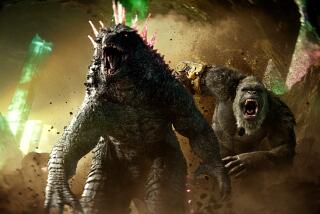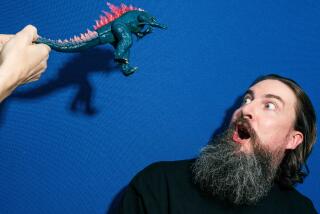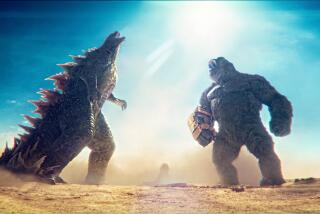Even Godzilla Movie’s Gotta Have Heart
All across town, you hear the screams about the disappointing returns for Sony/TriStar’s “Godzilla,” hoisting up the movie as an emblem of the failure of an intrusive marketing campaign hyping a flick with kindergarten dialogue and character conflicts that pack all the power of “Airport 1975” (“Sony Is Finding Out That Size of Prediction Matters,” Calendar, June 1).
All of which is beside the point. Hollywood thrives on mega-budgeted, heavily marketed films with rotten scripts; how else to explain the success of “Independence Day,” an advertising blitzkrieg for some ‘50s hokum about alien nasties? So why explain “Godzilla’s” failure with the same criteria? No one has suggested the real reason the Big G failed to start the expected box-office rampage: TriStar did not make a “Godzilla” film.
Oh, sure, director Roland Emmerich and producer Dean Devlin made a flick about a big lizard with a radioactive history, but such does not make a “Godzilla” film. Look at any of the Japanese classics, even the atrocious “Godzilla vs. Megalon,” and you’ll see what Emmerich and Devlin sadly ignored: the soul of the creature. From his first frightening appearance in 1954 to his poignant death in 1995’s “Godzilla vs. Destroyer” (never made available in the U.S.), the beast the Japanese call “Gojira” has proved that a guy in a rubber suit can still be a stunning monster, an awesome force so terrifying and enthralling it almost becomes beautiful.
Producer Tomoyuki Tanaka’s original creature may not have been a realistic dinosaur, but he was power, personality and destiny brilliantly combined. As one character summed up at the close of 1993’s “Godzilla vs. Mechagodzilla”: “He’ll never know it, but something powerful is protecting him.”
I loved “Godzilla” when I was a kid, and looking back over the years, I still adore the big lug. He smashed cities, unstoppable as the bomb that created him. Planes, tanks, missiles and lasers blazed at him, and he didn’t even slow down. His radioactive blasts obliterated all in his path. World leaders trembled as they raced frantically to stop his rampage and at the same time understand the meaning of it. His towering bulk faced menaces from the stars (the awesome three-headed dragon, King Ghidorah), godlike beings of peace and spirituality (Mothra, almost as popular in the homeland as his scaly foe) and atomically enhanced dinosaurs like himself (sonic-boom beast Rodan).
So what do Emmerich and Devlin give us? A big iguana with squinty eyes, Jay Leno’s chin and bad breath instead of flames. He’s also a spineless wimp, dodging buildings, fleeing helicopters and hiding in the subways. The real Godzilla would never hide. But this lizard who has temporarily usurped the name Godzilla has reason to run: All it takes to kill him are a couple of missiles in his side.
The true Godzilla once crawled through the mantle of the Earth and emerged from Mt. Fuji; four missiles might dislodge his contacts.
To kill time while this pseudo-zilla takes a nap, the filmmakers clutter the screen with a “Jurassic Park” raptor rip-off in Madison Square Garden.
Excuse me, but am I in the wrong theater? I want the fun and the imagination of “Godzilla.” I don’t want a believable computer graphics monster if this is what “believable” means. I want the guy in the suit, the monster with meaning and message, whether he’s a radioactive nightmare haunting postwar Japan or a superhero facing down his diabolic robot duplicate. I think that’s what audiences wanted as well--and didn’t get.
“Godzilla” didn’t let TriStar down. TriStar let “Godzilla” down.
More to Read
Only good movies
Get the Indie Focus newsletter, Mark Olsen's weekly guide to the world of cinema.
You may occasionally receive promotional content from the Los Angeles Times.









